engine CITROEN C6 2012 Handbook (in English)
[x] Cancel search | Manufacturer: CITROEN, Model Year: 2012, Model line: C6, Model: CITROEN C6 2012Pages: 216, PDF Size: 10.23 MB
Page 74 of 216
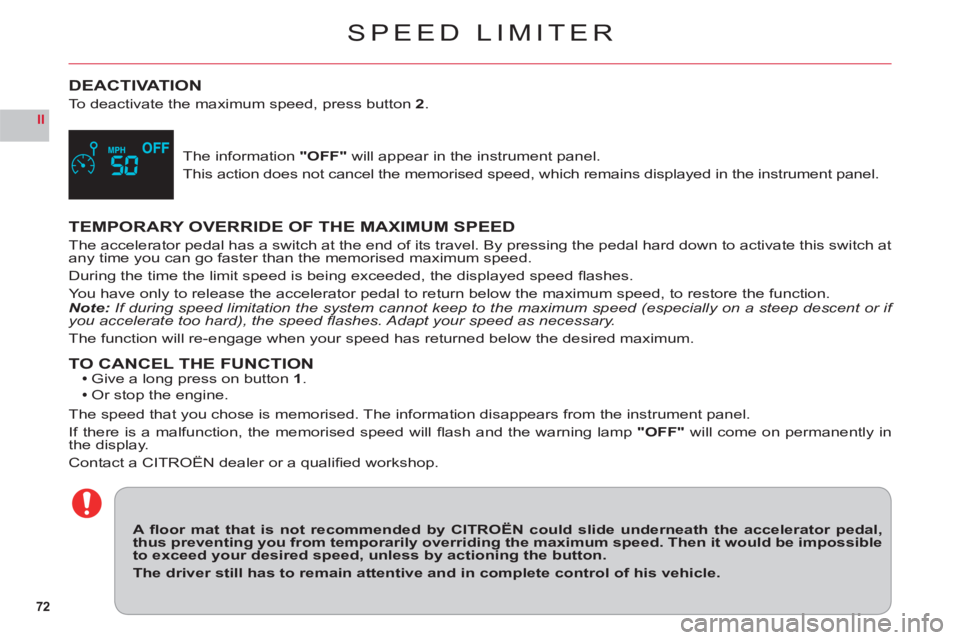
72
II
SPEED LIMITER
DEACTIVATION
To deactivate the maximum speed, press button2.
The information "OFF" will appear in the instrument panel.
This action does not cancel the memorised speed, which remains displayed in the instrument panel.
TEMPORARY OVERRIDE OF THE MAXIMUM SPEED
The accelerator pedal has a switch at the end of its travel. By pressing the pedal hard down to activate this switch at
any time you can go faster than the memorised maximum speed.
Durin
g the time the limit speed is being exceeded, the displayed speed fl ashes.
You have only to release the accelerator pedal to return below the maximum speed, to restore the function.Note:If during speed limitation the system cannot keep to the maximum speed (especially on a steep descent or if
you accelerate too hard), the speed fl ashes. Adapt your speed as necessary.
The function will re-engage when your speed has returned below the desired maximum.
TO CANCEL THE FUNCTIONGive a long press on button1.Or stop the engine.
The speed that you chose is memorised. The information disappears from the instrument panel.
I
f there is a malfunction, the memorised speed will fl ash and the warning lamp "OFF" will come on permanently in
the display.
Contact a CITROËN dealer or a qualifi ed workshop.
A fl oor mat that is not recommended by CITROËN could slide underneath the accelerator pedal,thus preventing you from temporarily overriding the maximum speed. Then it would be impossibleto exceed your desired speed, unless by actioning the button.
The driver still has to remain attentive and in complete control of his vehicle.
Page 75 of 216
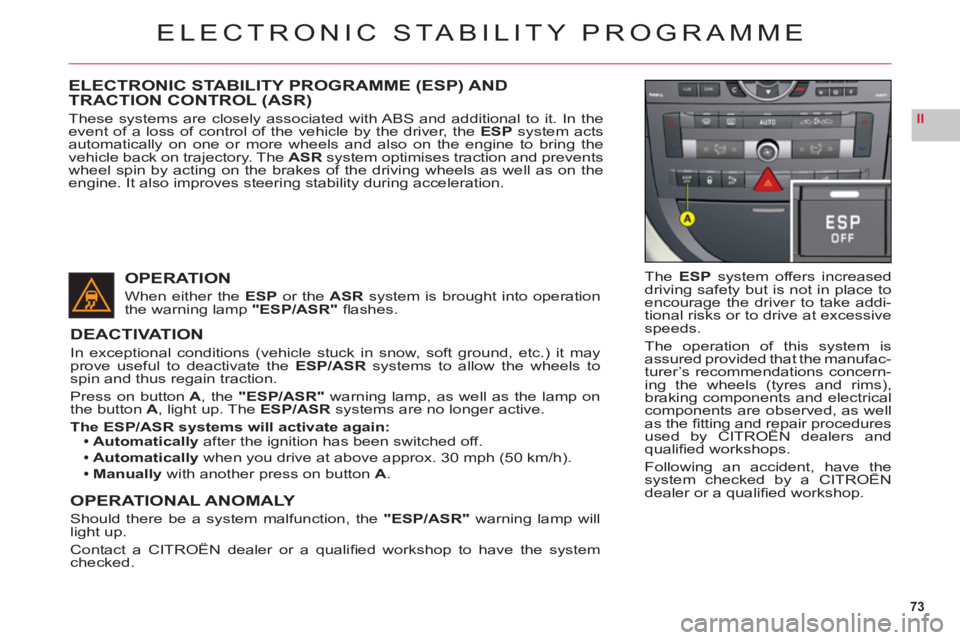
73
II
ELECTRONIC STABILITY PROGRAMME
TheESP system offers increased
driving safety but is not in place toencourage the driver to take addi-
tional risks or to drive at excessivespeeds.
The operation of this s
ystem is
assured provided that the manufac-
turer’s recommendations concern-
ing the wheels (tyres and rims),
braking components and electricalcomponents are observed, as wellas the fi tting and repair proceduresused by CITROËN dealers andgpp
qualifi ed workshops.
Following an accident, have thesystem checked by a CITROËNg,
dealer or a qualifi ed workshop.
ELECTRONIC STABILITY PROGRAMME (ESP) AND TRACTION CONTROL (ASR)
These systems are closely associated with ABS and additional to it. In the event of a loss of control of the vehicle by the driver, theESPsystem acts
automatically on one or more wheels and also on the engine to bring the
vehicle back on trajectory. The ASRsystem optimises traction and prevents
wheel spin by acting on the brakes of the driving wheels as well as on the engine. It also improves steering stability during acceleration.
OPERATION
When either the ESPor the ASR system is brought into operation
the warning lamp "ESP/ASR" fl ashes.
DEACTIVATION
In exceptional conditions (vehicle stuck in snow, soft ground, etc.) it mayprove useful to deactivate theESP/ASR systems to allow the wheels tospin and thus regain traction.
Press on buttonA, the"ESP/ASR" warning lamp, as well as the lamp on
the buttonA, light up. TheESP/ASR systems are no longer active.
The ESP/ASR systems will activate again:Automatically after the ignition has been switched off.
Automatically when you drive at above approx. 30 mph (50 km/h).
Manuallywith another press on button A.
OPERATIONAL ANOMALY
Should there be a system malfunction, the "ESP/ASR"warning lamp willlight up.
Contact a CITROËN dealer or a qualifi ed workshop to have the systemchecked.
Page 77 of 216

75
II
A
ELECTRIC PARKING BRAKE
OPERATION
To park
With the vehicle stationary, operate
the parking brakeby pulling thenreleasing the controlA.Note:In all circumstances with an
automatic gearbox, select the
Park position P.
On steep
gradients, turn the steering towards the pavement.It is not possible to release the electric parking brake if the key is removed or in position S.
•
•
•
To move off
With the engine running, release
the electric parking brake, by pres-
sing the brake pedal or the acce-lerator pedal and pulling then
releasing the control A.
You are advised not to clean underneath the vehicle using ahigh pressure system, as this could damage the electric parkingbrake.
Do not use the accelerator to hold your vehicle while on an incline.Use either the brake pedal or the electric parking brake.
The warning lamp comes
on if the parking brake isonor not properly releasedor if you try to release thebrakewithout pressing on thebrake pedal.
If these two warning
lamps come on
to
gether, this indica-
tes that the electric parking brake is malfunctioning.
The brake is on.
If this warning lamp comes
on, this indicates that the
electric parking brake is malfunctioning.
Th
e brake is not on.With an automatic gearbox, place the gearbox on position P.With a manual gearbox, engage fi rst gear.
•
•
Page 79 of 216
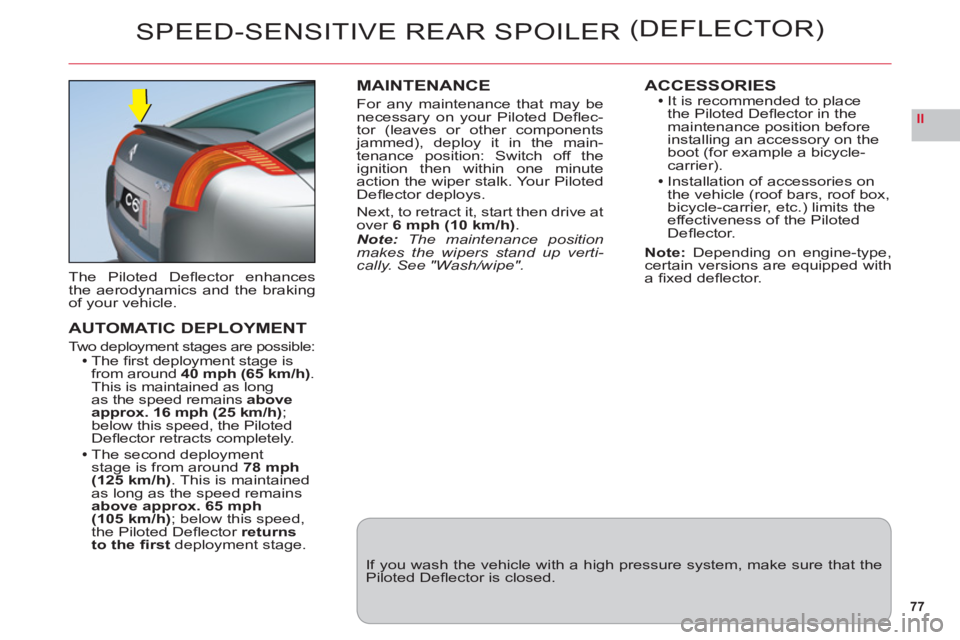
77
II
SPEED-SENSITIVE REAR SPOILER (DEFLECTOR)
The Piloted Defl ector enhancesthe aerodynamics and the brakingof your vehicle.
AUTOMATIC DEPLOYMENT
Two deployment stages are possible:The fi rst deployment stage isfrom around 40 mph (65 km/h).This is maintained as long
as the speed remainsabove approx.16 mph (25 km/h);
below this speed, the Piloted
Defl ector retracts completely.
The second deploymentstage is from around 78 mph(125 km/h). This is maintained
as long as the speed remainsabove approx.65 mph (105 km/h); below this speed,
the Piloted Defl ector returns
to the fi rstdeployment stage.
MAINTENANCE
For any maintenance that may be
necessary on your Piloted Defl ec-
tor (leaves or other components jammed), deploy it in the main-
tenance position: Switch off the
ignition then within one minute
action the wiper stalk. Your Piloted
Defl ector deploys.
Next, to retract it, start then drive at
over 6 mph (10 km/h).Note: The maintenance position makes the wipers stand up verti-cally. See "Wash/wipe".
ACCESSORIESIt is recommended to place
the Piloted Defl ector in themaintenance position before
installing an accessory on the
boot (for example a bicycle-carrier).Installation of accessories on
the vehicle (roof bars, roof box,
bicycle-carrier, etc.) limits theeffectiveness of the Piloted Defl ector.
Note:Depending on engine-type,certain versions are equipped witha fi xed defl ector.
If you wash the vehicle with a high pressure system, make sure that thePiloted Defl ector is closed.
Page 82 of 216
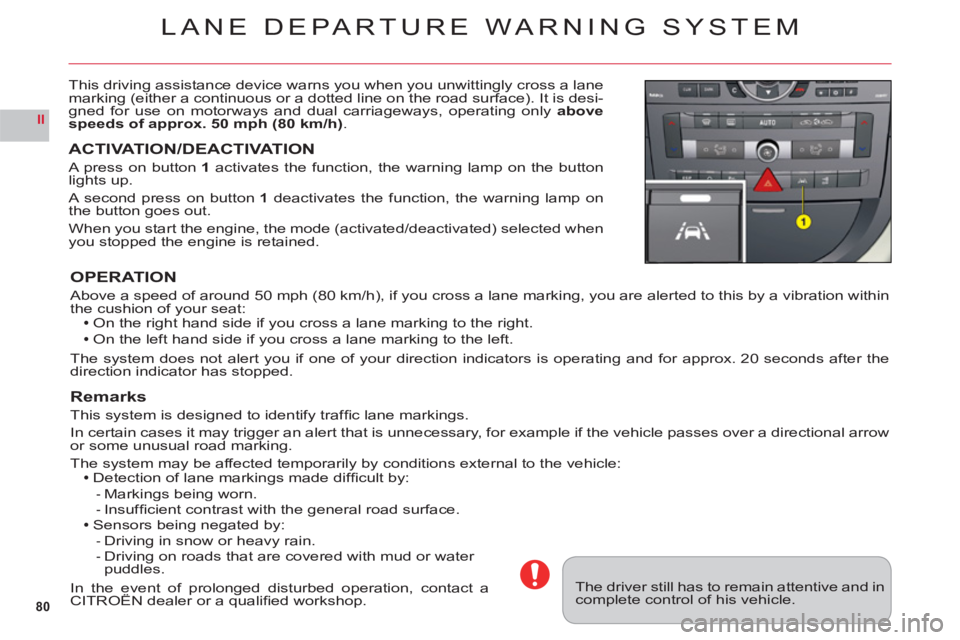
80
II
LANE DEPARTURE WARNING SYSTEM
This driving assistance device warns you when you unwittingly cross a lane marking (either a continuous or a dotted line on the road surface). It is desi-gned for use on motorways and dual carriageways, operating onlyabove
speeds of approx.50 mph (80 km/h).
ACTIVATION/DEACTIVATION
A press on button 1activates the function, the warning lamp on the button lights up.
A second press on button 1 deactivates the function, the warning lamp on
the button goes out.
When you start the engine, the mode (activated/deactivated) selected when you stopped the engine is retained.
OPERATION
Above a speed of around 50 mph (80 km/h), if you cross a lane marking, you are alerted to this by a vibration within
the cushion of your seat:On the right hand side if you cross a lane marking to the right.
On the left hand side if you cross a lane marking to the left.
The system does not alert you if one of your direction indicators is operating and for approx. 20 seconds after the
direction indicator has stopped.
Remarks
This system is designed to identify traffi c lane markings.
In certain cases it ma
y trigger an alert that is unnecessary, for example if the vehicle passes over a directional arrow
or some unusual road marking.
The system may be affected temporarily by conditions external to the vehicle:Detection of lane markings made diffi cult by:
Markings being worn.Insuffi cient contrast with the general road surface.Sensors being negated by:
Driving in snow or heavy rain.Driving on roads that are covered with mud or water puddles.
In the event of prolonged disturbed operation, contact aCITROÀN dealer or a qualifi ed workshop.pg p
--
--
The driver still has to remain attentive and in complete control of his vehicle.
Page 84 of 216
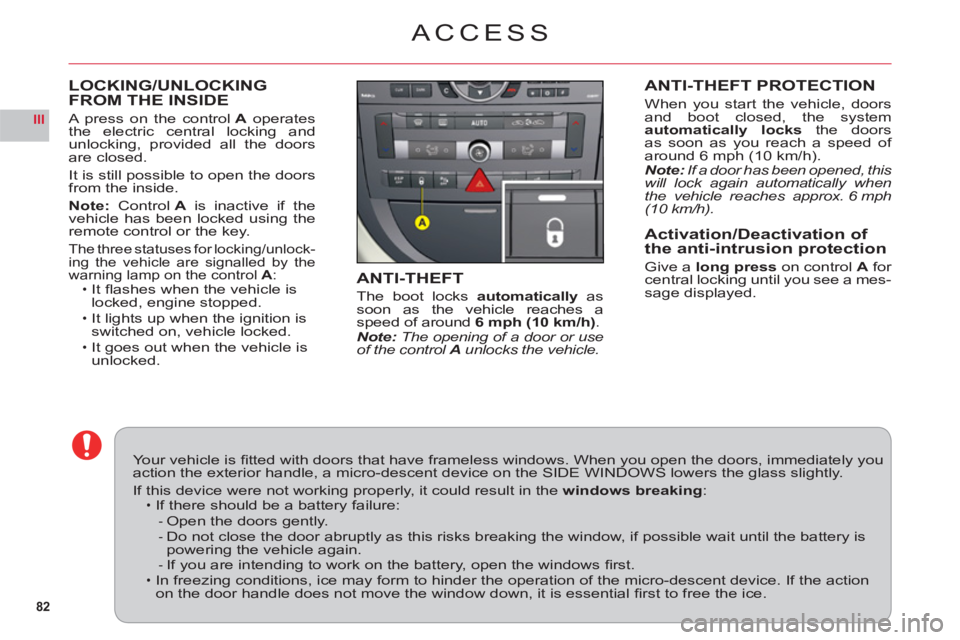
82
III
LOCKING/UNLOCKING
FROM THE INSIDE
A press on the controlA operates
the electric central locking andunlocking, provided all the doorsare closed.
It is still possible to open the doorsfrom the inside.
Note: ControlAis inactive if thevehicle has been locked using theremote control or the key.
The three statuses for locking/unlock-ing the vehicle are signalled by the
warning lamp on the control A:It fl ashes when the vehicle is
locked, engine stopped.
It lights up when the ignition is switched on, vehicle locked.It goes out when the vehicle is unlocked.
ï
ï
ï
ACCESS
ANTI-THEFT PROTECTION
When you start the vehicle, doors
and boot closed, the system
automatically locksthe doorsas soon as you reach a speed of
around 6 mph (10 km/h).Note: If a door has been opened, this will lock again automatically whenthe vehicle reaches approx. 6 mph(10 km/h).
Activation/Deactivation of
the anti-intrusion protection
Give a long press on control Afor central locking until you see a mes-sage displayed.ANTI-THEFT
The boot locks automatically as soon as the vehicle reaches a
speed of around6 mph (10 km/h).Note: The opening of a door or use of the control A unlocks the vehicle.
Your vehicle is fi tted with doors that have frameless windows. When you open the doors, immediately youaction the exterior handle, a micro-descent device on the SIDE WINDOWS lowers the glass slightly.
If this device were not working properly, it could result in thewindows breaking:If there should be a battery failure:
Open the doors gently.Do not close the door abruptly as this risks breaking the window, if possible wait until the battery ispowering the vehicle again.If you are intending to work on the battery, open the windows fi rst.In freezing conditions, ice may form to hinder the operation of the micro-descent device. If the actionon the door handle does not move the window down, it is essential fi rst to free the ice.
ï
--
-ï
Page 88 of 216

86
III
AUTOMATIC AIR CONDITIONING
AIR CONDITIONING
This system automatically adjusts the temperature, the fl ow of air and the distribution of air inside the cabin,
depending on your desired comfort level.
Provided
you retain automatic mode (by pressing button "AUTO") and all the air vents are open, you will main-
tain an optimum comfort level, also removing humidity
and misting, whatever the ambient climatic conditions.
The temperature inside the cabin cannot be lower than
the temperature outside if the air conditioning is not
operating.
To be e
ffective, the air conditioning should only be used
with the windows closed. If after a lengthy stop in bright sunlight the interior temperature is excessive, air the passenger compartment by opening the windows for a
few moments, then close them again.
To keep the air conditioning compressor well sealed, it
is essential to operate the air conditioning at least once every month.
The air conditioning operates by using power from the engine. This results in a slight increase in fuel con-sumption.
Sensors
The automatic regulation of the air conditioning inside
the cabin makes use of a number of sensors, relieving you of the need to make adjustments, other than the desired cabin temperature.
Take care not to obstruct sensor A.
Air inlet
Check that the exterior grille for the air inlet, at the bot-
tom of the windscreen, is clean and free of dead leaves,snow, etc.
If washing the vehicle with a high pressure jet, avoid
targeting the air inlet zone.
Air circulation
For your comfort we advise you to maintain a proper
distribution of air within the cabin, both at the front andat the rear.
The air vents to the
face have thumbwheels so that you can
adjust the fl ow of air, and grilles to orient the direction.
Th
ere are air vents on the fl oor underneath the frontseats and on the rear control panel, for enhancedheating of the rear seat positions.
Do not obstruct the air outlets located in the boot area.
Dust/pollen fi lter
There is a fi lter for excluding pollen and dust.
This
fi lter has to be changed according to the vehicle
maintenance schedule. See "Maintenance and WarrantyGuide".
Page 90 of 216
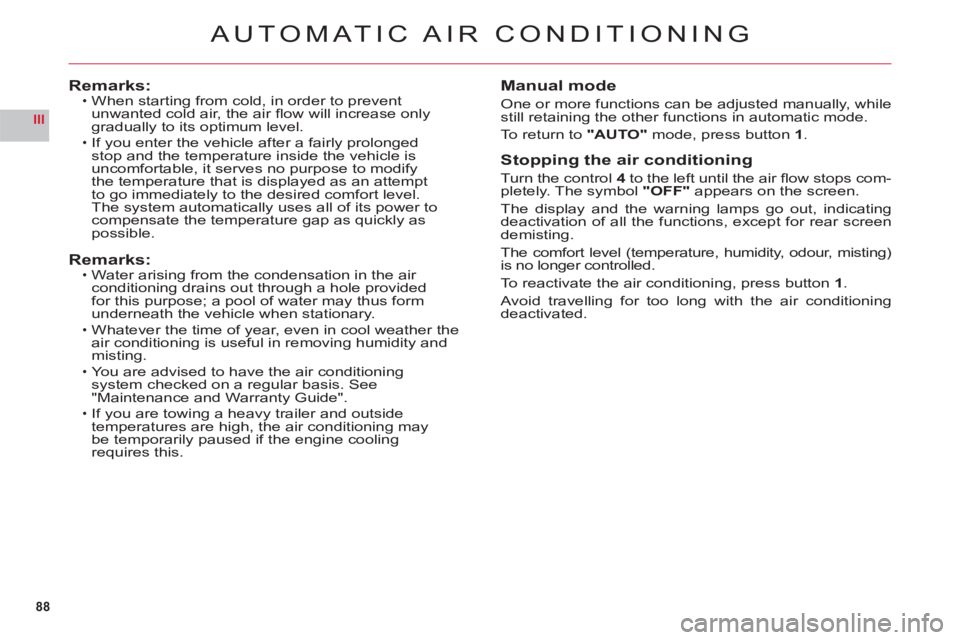
88
III
AUTOMATIC AIR CONDITIONING
Remarks:When starting from cold, in order to prevent
unwanted cold air, the air fl ow will increase onlygradually to its optimum level.
If you enter the vehicle after a fairly prolongedstop and the temperature inside the vehicle is
uncomfortable, it serves no purpose to modify
the temperature that is displayed as an attempt
to go immediately to the desired comfort level.
The system automatically uses all of its power tocompensate the temperature gap as quickly as possible.
Remarks:Water arising from the condensation in the air conditioning drains out through a hole provided for this purpose; a pool of water may thus form
underneath the vehicle when stationary.
Whatever the time of year, even in cool weather the
air conditioning is useful in removing humidity and
misting.
You are advised to have the air conditioning system checked on a regular basis. See
"Maintenance and Warranty Guide".
If you are towing a heavy trailer and outside
temperatures are high, the air conditioning may
be temporarily paused if the engine cooling
requires this.
•
•
•
•
•
•
Manual mode
One or more functions can be adjusted manually, whilestill retaining the other functions in automatic mode.
To return to"AUTO" mode, press button 1.
Stopping the air conditioning
Turn the control4to the left until the air fl ow stops com-pletely. The symbol "OFF"appears on the screen.
The display and the warning lamps go out, indicatingdeactivation of all the functions, except for rear screen
demisting.
The com
fort level (temperature, humidity, odour, misting)is no longer controlled.
To reactivate the air conditioning, press button 1.
Avoid travelling for too long with the air conditioningdeactivated.
Page 92 of 216

90
III
5
6
7
AUTOMATIC AIR CONDITIONING
5. FRONT DEMISTING - DEICING
Press button 5 for rapidclear windows. The warning lamp comes on. This system controls the air condi-
tioning, the air fl ow and the entry of air from outside. It sends the ventilation towards the windscreen and side
windows.
A press on the 1 button returns you to "AUTO"mode.
6. REAR DEMISTING - DEICING
Press button 6, with the engine running, to start a rapid
deicing or demisting of the rear screen and rear view mirrors. The warning lamp comes on.
This mode stops automatically depending on the out-side temperature. It can be paused by pressing again on button6or by stopping the engine.
In the latter case, demisting will resume when the engine is switched on again.Note:The heated rear screen operates independently of the automatic air conditioning.
7. AIR RECIRCULATION – ENTRY OF AIR
FROM OUTSIDE
Press repeatedly on button7 to select the air entrymode. The corresponding warning lamp lights up:Air intake in automatic pollution control mode (on by default, with automatic comfort regulation).
The automatic mode makes use of an air quality sen-sor. It analyses the air and isolates the cabin from theexterior if the presence of pollutants is detected. In thiscase it automatically activates recirculation of the cabinair.
Please note: this function does not detect and there-fore protect the cabin from unpleasant odours. It is not
active when the ambient temperature is below +5 °C so
as to avoid the risk of misting the vehicle’s windows.
Closing the exterior air intake
Press button 7to close the intake of air from the exterior.
While maintaining the other settings, this position allows
the driver to avoid unpleasant odours and smoke out-
side the vehicle at any time.
It should be cancelled as soon as possible to allowexchange of the cabin air and to avoid misting of
the vehicle’s windows.
Exterior air intake
Press button7once to open the exterior air intake.
•
•
•
Page 95 of 216
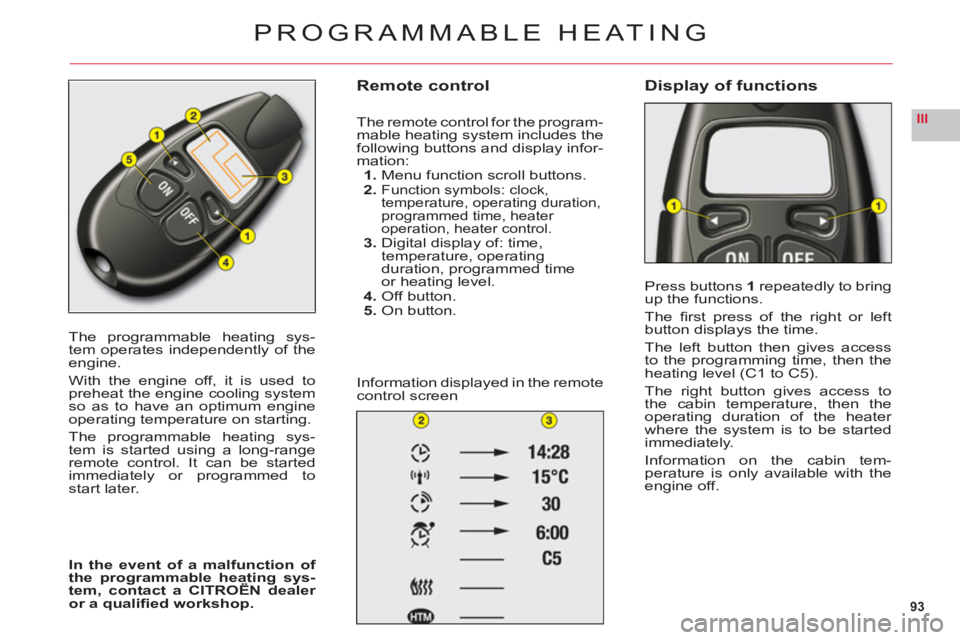
93
III
The programmable heating sys-
tem operates independently of theengine.
With the engine off, it is used topreheat the engine cooling systemso as to have an optimum engine
operating temperature on starting.
The programmable heating sys-
tem is started using a long-rangeremote control. It can be startedimmediately or programmed tostart later.
In the event of a malfunction of the programmable heating sys-tem, contact a CITROËN dealer pg gy
or a qualifi ed workshop.
Remote control
The remote control for the program-
mable heating system includes the following buttons and display infor-
mation:1. Menu function scroll buttons.
2. Function symbols: clock,
temperature, operating duration, programmed time, heater operation, heater control.3. Digital display of: time,
temperature, operating
duration, programmed time
or heating level.4. Off button.5. On button.
In
formation displayed in the remote control screen
Display of functions
Press buttons1repeatedly to bringup the functions.
The fi rst press of the ri
ght or leftbutton displays the time.
The left button then
gives access
to the programming time, then theheating level (C1 to C5).
The right button gives access to
the cabin temperature, then the
operating duration of the heater
where the system is to be startedimmediately.
In
formation on the cabin tem-perature is only available with theengine off.
PROGRAMMABLE HEATING